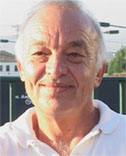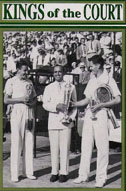Little Bill Johnston's
Forehand
Ed Atkinson
Little Bill Johnson was the first great champion in tennis history. And his "western"
forehand was one of the first great shots ever to be filmed. Taking a look at this rare historical
footage gives us a chance to see and to analyze it for the first time anywhere, right here on
Tennisplayer. I think you'll agree, it's an interesting mix of ancient and modern.
In the animation, note the size of the backswing. No modern player goes nearly as high with his hand or takes the racket so far behind the body. The closed stance with the western grip is also very different from the modern game. But watch the rotation of the hand and arm and the finish on the left side. This has been called the "new" modern finish, but this footage of Little Bill puts that in a different historical perspective.
 |
The start of the legendary Little Bill forehand. The immediate full shoulder turn is essential. Today this motion is called the unit turn. Interestingly, this initial part of the stroke was the same in the 1920s as it is today. It's not a question of getting your racket backit's a question of preparing with your body. Notice also how the left arm has started to come across the body and to his side. Again something"s are constant for great players of any era. |
 |
This is the close to the top of the loop with the shoulders fully turned. This is not what you would call a compact loop. No player in the modern game use a backswing this large, although Fernando Gonzalez is probably the closest. And from this position, he takes his racket fruther back behind his body! Johnston has also begun his step forward into the shot with the left front foot, transferring the body weight forward into the shot. This is very different than the modern players with similar grips who would all undoubtedly hit a ball of this height with an open stance. |
 |
Johnson has now stepped fully into the line of the shot--the source of power on Johnston's "heavy" ball was in his day attributed to the fact that his body weight was flowing into the shot, creating depth as well as raw power. That"s very different than the emphasis on rotation today. Note that the rear foot remains behind and doesn't swing around. The wrist is laid back but relaxed and will release naturally well after the hit. |
 |
At the critical moment of contact, Johnston extends his left arm slightly. This controls his body rotation. Here we see how the footwork and body rotation are related, and where history and modernity part ways. Unlike modern players, Little Bill rotates only until his shoulders are facing the net. They are actually a little less than facing the net at contact, more what we would expect from an eastern grip today. This is far less than modern players with grips that are less extreme than Little Bill's. |
 |
Immediately after contact the racket continues out on the line of the shot. The position of his front and rear foot has remained the same. Note the back foot remains behind and has not swung around through the shot. This is again different than the modern westernized forehand. Less rotation, no recovery step and possibly, more extension forward through the line of the shot. Note that the racket face is starting to turn over. |
 |
In the last frame we can the hand and arm rotation continuing to turn the racket face over. Here is another so-called modern element that proves anything but modern. The finish is going to be further across the body and lower, the way we associate with "advance" modern technique. What isn't "modern" is the way the left arm blocks the torso, and the feet stay planted. Again, in his day, this footwork was considered critical in generating pace and a heavy shot. |





